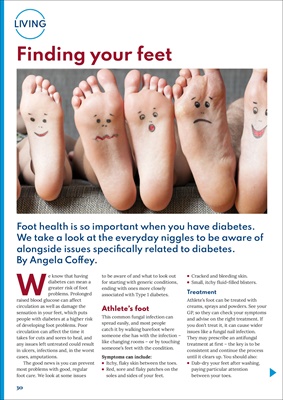
30
LIVING
Finding your feet
Foot health is so important when you have diabetes.
We take a look at the everyday niggles to be aware of
alongside issues specifically related to diabetes.
By Angela Coffey.
We know that having
diabetes can mean a
greater risk of foot
problems. Prolonged
raised blood glucose can affect
circulation as well as damage the
sensation in your feet, which puts
people with diabetes at a higher risk
of developing foot problems. Poor
circulation can affect the time it
takes for cuts and sores to heal, and
any issues left untreated could result
in ulcers, infections and, in the worst
cases, amputations.
The good news is you can prevent
most problems with good, regular
foot care. We look at some issues
to be aware of and what to look out
for starting with generic conditions,
ending with ones more closely
associated with Type 1 diabetes.
Athlete's foot
This common fungal infection can
spread easily, and most people
catch it by walking barefoot where
someone else has with the infection -
like changing rooms - or by touching
someone's feet with the condition.
Symptoms can include:
Itchy, flaky skin between the toes.
Red, sore and flaky patches on the
soles and sides of your feet.
Cracked and bleeding skin.
Small, itchy fluid-filled blisters.
Treatment
Athlete's foot can be treated with
creams, sprays and powders. See your
GP, so they can check your symptoms
and advise on the right treatment. If
you don't treat it, it can cause wider
issues like a fungal nail infection.
They may prescribe an antifungal
treatment at first - the key is to be
consistent and continue the process
until it clears up. You should also:
Dab-dry your feet after washing,
paying particular attention
between your toes.